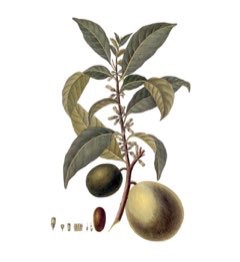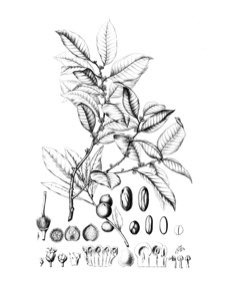 |
|
http://www.edibleplants.org |
 |
| http://www.edibleplants.org |
Translate this page:
Summary
Pouteria caimito or known in various common names such as Abiu and Yellow Star Apple is a tropical medium-sized tree growing about 10-15 m high and 30 cm in trunk diameter. It is cultivated for its bright yellow fruits with translucent flesh that has a jelly-like consistency and sweet flavor. When fully ripe, it is consumed raw or used in desserts and salads. The oblong to elliptic leaves are simple and arranged in alternate order. The flowers may occur singly or in clusters of two to five flowers. The crown is dense and the trunk is straight. Abiu is used medicinally for coughs, bronchitis, fever, and diarrhea. The wood is heavy and hard, moderately resistant to insect attack , and moderately durable. It is used for construction and external work. The plant is not tolerant to frost. Propagation can be through seed sowing, grafting, budding, or air layering.
Physical Characteristics

 Pouteria caimito is an evergreen Tree growing to 15 m (49ft) by 15 m (49ft) at a medium rate.
Pouteria caimito is an evergreen Tree growing to 15 m (49ft) by 15 m (49ft) at a medium rate.
See above for USDA hardiness. It is hardy to UK zone 10. The plant is self-fertile.
Suitable for: light (sandy), medium (loamy) and heavy (clay) soils. Suitable pH: mildly acid and neutral soils and can grow in very acid soils.
It can grow in semi-shade (light woodland) or no shade. It prefers moist or wet soil.
UK Hardiness Map
US Hardiness Map
Synonyms
Achras caimito Ruiz & Pav. Achras guapeda Casar. Caleatia caimito (Ruiz & Pav.) Mart. ex Steud. Guap
Plant Habitats
Edible Uses
Edible Parts: Fruit
Edible Uses:
The fully ripe fruit has a delicious flavour - it is eaten raw or used in sherbets and ice cream[301 , 317 ]. It goes particularly well in fruit salads, especially if they contain orange slices to add acidity[301 ]. A lovely bright yellow fruit with a whitish, translucent flesh that has a jelly-like consistency and a sweetish flavour[301 ]. The fruit has a flavour somewhat like a rambutan[296 ]. It is up to 10cm in diameter[296 ]. Fruit that is not fully ripe can contain a milky latex that sticks to the lips[301 ]. The fruit has a thin skin that bruises easily, so the fruit will not store for more than a few days[296 ].
References More on Edible Uses
Medicinal Uses
Plants For A Future can not take any responsibility for any adverse effects from the use of plants. Always seek advice from a professional before using a plant medicinally.
None known
References More on Medicinal Uses
The Bookshop: Edible Plant Books
Our Latest books on Perennial Plants For Food Forests and Permaculture Gardens in paperback or digital formats.

Edible Tropical Plants
Food Forest Plants for Hotter Conditions: 250+ Plants For Tropical Food Forests & Permaculture Gardens.
More

Edible Temperate Plants
Plants for Your Food Forest: 500 Plants for Temperate Food Forests & Permaculture Gardens.
More

More Books
PFAF have eight books available in paperback and digital formats. Browse the shop for more information.
Shop Now
Other Uses
Wood
Other Uses: The wood is heavy, hard, straight-grained, of medium texture[420 ]. It is moderately resistant to insect attack, and moderately durable[420 ]. It is used for construction and external work[420 ].
Special Uses
Food Forest
References More on Other Uses
Cultivation details
A tree of the hot, wet, tropical lowlands, it requires a year-round moist and warm climate[335 , 377 ]. Plants are intolerant of frost[335 ]. Succeeds in full sun and in dappled shade[420 ]. Grows well in wet soils[377 ]. Prefers an acid soil[335 ]. Seedling trees take up to 8 years before they start to fruit, and some are very shy fruiters[296 ]. It is therefore best to propagate vegetatively from good fruiting forms[296 ]. Grafted plants can fruit in 3 - 4 years[335 ]. Good forms can fruit twice a year[296 ]. Mature trees may produce anywhere from 100 - 1,000 fruits a year[377 ]. A large tree, it is best kept pruned to about 4 metres tall in order to make fruit harvest easier[296 ]. There are some named varieties[301 ]. The quality of the fruits is much higher in recent selected strains[317 ]. Some forms are self-fertile, though others need cross-pollination[335 ].
References Carbon Farming Information and Carbon Sequestration Information
Temperature Converter
Type a value in the Celsius field to convert the value to Fahrenheit:
Fahrenheit:
The PFAF Bookshop
Plants For A Future have a number of books available in paperback and digital form. Book titles include Edible Plants, Edible Perennials, Edible Trees,Edible Shrubs, Woodland Gardening, and Temperate Food Forest Plants. Our new book is Food Forest Plants For Hotter Conditions (Tropical and Sub-Tropical).
Shop Now
Plant Propagation
Seed - remove it from its husk before sowing[200 ]. Best sown as soon as it is ripe[420 ]. Sow in a nursery seedbed in semi-shade. When sown fresh, the seed usually germinates in 4 - 6 weeks, with a reasonable percentage germinating[377 , 420 ]. Side-grafting. Air-layering may be possible[200 ].
Other Names
If available other names are mentioned here
Abiero, Aguaycillo, Asepokoballi, Caimitillo, Caimo, Cauje, Coloradillo de la bajura, Ingi-oedoe, Luma, Pepeboiti, Temare, Yaas, Yellow star apple, caimito.
Native Plant Search
Search over 900 plants ideal for food forests and permaculture gardens. Filter to search native plants to your area. The plants selected are the plants in our book 'Plants For Your Food Forest: 500 Plants for Temperate Food Forests and Permaculture Gardens, as well as plants chosen for our forthcoming related books for Tropical/Hot Wet Climates and Mediterranean/Hot Dry Climates. Native Plant Search
Found In
Countries where the plant has been found are listed here if the information is available
Costa Rica; Panama; French Guiana; Guyana; Suriname; Venezuela, Bolivarian Republic of; Bolivia, Plurinational State of; Colombia; Ecuador; Peru; Nicaragua; Trinidad and Tobago; Brazil, Amazon, Andes, Australia, Bolivia*, Brazil*, Central America, Hawaii, Nicaragua, Pacific, Panama, South America, Suriname, USA, Venezuela,
Weed Potential
Right plant wrong place. We are currently updating this section.
Please note that a plant may be invasive in one area but may not in your area so it’s worth checking.
Conservation Status
IUCN Red List of Threatened Plants Status : This taxon has not yet been assessed

Growth: S = slow M = medium F = fast. Soil: L = light (sandy) M = medium H = heavy (clay). pH: A = acid N = neutral B = basic (alkaline). Shade: F = full shade S = semi-shade N = no shade. Moisture: D = dry M = Moist We = wet Wa = water.

Expert comment
Author
(Ruiz & Pav.) Radlk.
Botanical References
Links / References
For a list of references used on this page please go here
A special thanks to Ken Fern for some of the information used on this page.
Readers comment
| Add a comment |
|
If you have important information about this plant that may help other users please add a comment or link below. Only comments or links that are felt to be directly relevant to a plant will be included. If you think a comment/link or information contained on this page is inaccurate or misleading we would welcome your feedback at [email protected]. If you have questions about a plant please use the Forum on this website as we do not have the resources to answer questions ourselves.
* Please note: the comments by website users are not necessarily those held by PFAF and may give misleading or inaccurate information.
To leave a comment please Register or login here All comments need to be approved so will not appear immediately.
|
Subject : Pouteria caimito
|
|
|
|